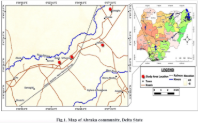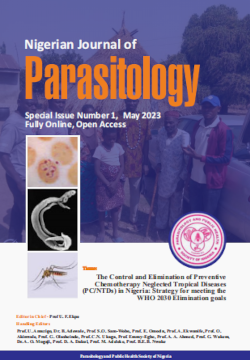Molecular Confirmation of Anopheles coluzzii as the Major Malaria Vector in Relation to Seasonal Abundance, Biting Behaviour, and Wing Development for Vectoral Capacity in Abraka, Delta State, Nigeria
DOI:
https://doi.org/10.4314/njpar.v46i1.2Keywords:
Anopheles coluzzii, entomological indices, molecular confirmation, Delta StateAbstract
A proper understanding of the dynamics of malaria vectors is an important tool for vector control measures and the prevention of mosquito bites within the study area. This study was conducted to determine the species composition, biting behaviour, and abundance of mosquitoes with respect to seasons in the sampled mosquitoes in Abraka community of Ethiope East L.G.A, Delta State, Nigeria. Adult Anopheles mosquitoes were collected indoors and outdoors using CDC light traps for 10 months; from May 2022 to February 2023 and the entomological indices were examined. A total of 343 mosquitoes were obtained from this study, and the difference between outdoor and indoor mosquitoes was significant (p<0.05). The collected Anopheles mosquitoes were morphologically identified as Anopheles gambiae sensu lato. PCR screening confirmed the presence of Anopheles coluzzii. The wing lengths of the mosquitoes obtained outdoors were significantly (p<0.05) longer than those obtained indoors. Furthermore, biting peaks were observed between the hours of 8-9 pm and 2-3 am. The differences between the abundance of mosquitoes with time and traps were significant (F (biting = 6.10, p= 0.0028; F =20.97, p= 0.0008). Mosquitoes were more abundant intime) (trap) September (especially indoors) than in the other sampled months, and the lowest catch was in August. The number of mosquitoes obtained in the rainy months was significantly higher (F =6.56, p= 0.03) than that in the dry months.(seasons) Sporozoites were not found in the mosquitoes. In conclusion, the findings of this study showed that An. coluzzii was the major malaria vector in this location. Hence, targeted outdoor mosquito control measures should be applied before September to reduce the malaria burden in the study area.
References
Coetzee, M. (2020). Key to the females of Afrotropical Anopheles mosquitoes (Diptera: Culicidae). Malaria Journal,19(1):70. https://doi.org/10.1186/s12936-020-3144-9.
Degefa, T., Yewhalaw, D., Zhou, G., Lee, M., Atieli, H., Andrew, K. G. and Yan, G. (2017). Indoor and outdoor malaria vector surveillance in western Kenya: implications for better understanding of residual transmission. Malaria Journal, 16:443. https://doi.org/10.1186/s12936-017-2098-z.
Onodua, E., Odo, P. E. and Egwunyenga A. O. (2020). Mosquito Species Abundance, Distribution and Diversity in Ughelli North Local Government Area, Delta State, Nigeria. Nigeria Annals of Pure and Applied Science, 41-55.
Ojianwuna, C. C., Enwemiwe, V. N., and Ekeazu, C. N. (2021). Abundance and distribution of Anopheles mosquitoes in relation to physicochemical properties in Delta State, Nigeria. FUDMA Journal of Science, 5(3): 274-280. https://doi.org/10.33003/fjs-2021-0503-752
Hoo, R., Zhu, L., Amaladoss, A., Mok, S., Natalang, O. and Lapp, S. A. (2016). Integrated analysis of the Plasmodium species transcriptome. EBioMedicine, 7:255–66.
WHO. (2021). World Malaria Report 2021. Geneva. World Health Organization, 2021.
https://apps.who.int/iris/handle/10665/350147 Accessed 11th November 2023.
WHO. (2020). World Malaria Report 2020. Geneva, World Health Organization
Lamidi, B. T., Naphtali, R. S., Alo, E. B. and Oyeniyi, A. T. (2017). Malaria vector population density and man-biting rate in three selected areas of Taraba State, North-east, Nigeria. Nigerian Journal of Parasitology, 39(2): 23-28.
Conteh, L., Shuford, K., Agboraw, E., Kont, M., Kolaczinski, J. and Patouillard, E. (2021). Costs and cost effectiveness of malaria control interventions: A systematic Literature review. Value Health, 24(8): 1213-1222. https://doi.org/10.1016/j.jval.2021.01.013.
Garba, Y. (2023). Distribution of the African malaria vector (Anopheline mosquitoes) in Kontagora, North Central, Nigeria. Journal of Applied Science and Environmental Management, 27(4): 787-791. https://doi.org/10.4314/jasem.v27i4.21.
Egedegbe, A. O., Ojianwuna, C. C., Enwemiwe, V. N., Omotayo, A. I., Eyeboka, D. N. and Esiwo, E. (2023). Molecular characterization and potentiality of Anopheles coluzzii in disease transmission in different communities in Ughelli North LGA, Delta State, Nigeria. Animal Research International, 20(2): 4988-5006.
Afrane, Y. A., Abdulai, A., Mohammed, A. R., Akuamoah-Boateng, Y., Owusu-Asenso, C. M., Sraku, I. K., Yanney, S. A., Malm, K., Lobo, N. F. (2023). First detection of Anopheles stephensi in Ghana using molecular surveillance. BioRxiv [preprint].12.01.569589. https://doi.org/10.1101/2023. 12.01.569589.
Moyo, M., Lawrence, G. G., Bobanga, T. and Irish, S. R. (2021). Molecular confirmation of Anopheles melas (Diptera: Culicidae) in Democratic Republic of Congo. African Entomology, 29: 1.
https://doi.org/10.4001/003.029.0298.
Christen, M., Fornadel, L. N., and Douglas, E. N. (2010) Centers for Disease Control Light Traps for Monitoring Anopheles arabiensis Human Biting Rates in an Area with Low Vector Density and High Insecticide-Treated Bed Net Use. America Journal of Tropical Medicine and Hygiene, 83(4): 838–842. https://doi.org/10.4269/ajtmh.2010.10-0088.
Ojianwuna, C. C., Ilondu, E. M. and Enwemiwe, V. N. (2021). Larvicidal efficacy of leaf extracts from three asteraceous plants against mosquito (Culex quinquefasciatus). FUDMA Journal of Sciences, 5(2): 100-108. https://doi.org/10.33003/fjs-2021-0502-528
Ojianwuna, C. C., Enwemiwe, V. N. and Erhunmwun, S. (2021b). Effect of petroleum products on larvicidal activity of Aedes mosquitoes in Ika north-east LGA, Delta state, Nigeria. Open Ecology Journal, 14:24-30. https://doi.org/10.2174/2590277602114010024.
Ojianwuna, C. C. and Enwemiwe, V. N. (2022). Insecticidal effectiveness of naphthalene and its combination with kerosene against the emergence of Aedes aegypti in Ika North East, LGA, Delta State, Nigeria. Parasite Epidemiology and Control, 18: e00259. https://doi.org/10.1016/j.parepi.2022.e00259.https://doi.org/10.1016/j.parepi.2022.e00259
Saili, K. J., Sangoro, O. P., Nkya, T. E., Masaninga, F., Mwenya M., Sinyolo, A., Hamainza, B., Chanda, E., Fillinger U., and Mutero C. M. (2023). Anopheles rufipes implicated in malaria transmission both indoors and outdoors alongside Anopheles funestus and Anopheles arabiensis in rural south-east Zambia. Malaria Journal, 22: 95. https://doi.org/10.1186/s12936-0.23-04489-3.
Ezihe, E. K., Chikezie, F. M., Egbuche, C. M., Nwankwo, E. N., Onyido, A. E., Aribodor, D. and Samdi, M. L. (2017). Seasonal distribution and micro-climatic factors influencing the abundance of the malaria vectors in south-east Nigeria. Journal of Mosquito Research, 7(3): 15-26 https://doi.org/10.5376/jmr.2017.07.0003.
Bedasso, A. H., Gutto, A. A., Waldetensai, A., Eukubay, A., Bokore, G. E., Kinde, S., Gemechu, F., Debebe, Y., Aklilu, M., Tasew, G., Massebo, F., Teshome, A., Kebede, T., Abdulatif, B., Sisay, A., Solomon, H., and Kweka, E. J. (2022). Malaria vector feeding, peak biting time and resting place preference behaviours in line with Indoor based intervention tools and its implication: scenario from selected sentinel sites of Ethiopia. Heliyon, 8(12): e12178.https://doi.org/10.1016/j.heliyon.2022.e12178.
Ototo, E. N., Mbugi, J. P., Wanjala, C. L., Zhou, G., Githeko, A. K., and Yan, G. (2015). Surveillance of malaria vector population density and biting behaviour in western Kenya. Malaria Journal,14:244. https://doi.org/10.1186/s12936-015-0763-7.
Aketu, A. V., Olusi, T. A. and Simon-Oke, I. A. (2022). Molecular identification and wing variations among malaria vectors in Akure North Local Government Area, Nigeria. Scientific Report, 12: 7674. https://doi.org/10.1038/s41598-022-11917-y.
Ombugadu, A., Ekawu, R. A., Odey, S. A., Igboanugo, S. I., Luka, J., Njila, H. L., Ajah, L. J., Adejoh, V. A., Micah, E. M., Echor, B. O., Samuel, M. D., Dogo, K. S., Ahmed, H. O., Ayim, J. O., Ewa, P. E., Aimankhu, O. P., Uzoigwe, N. R., Mafuyai, M. J., Yina, G. I., Pam, D. D., Lapang, M. P., Aliyu, A. A., Ayuba, S. O., Nkup, C. D., Angbalaga, G. A. and Mwansat, G. S. (2020). Feeding Behaviour of Mosquito Species in Mararraba-Akunza, Lafia Local Government Area, Nasarawa State, Nigeria. Biomedical Journal of Science and Technical Research, 25(1): 18742-
https://doi.org/10.26717/BJSTR.2020.25.004133.
Zemene, E., Denekew, B. B., Abebaw, T., Ming Chieh, L., Delenasaw, Y. and Guiyun, Y. (2021). Malaria vector dynamics and utilization of insecticide-treated nets in low-transmission setting in Southwest Ethiopia: implications for residual transmission. BMC Infectious Disease, 21: 882. https://doi.org/10.1186/s12879-021-06592-9.
Demas, A., Oberstaller, J., Debarry, J., Lucchi, N. W., Srinivasamoorthy, G., Sumari, D., Kabanywanyi, A. M., Villegas, L., Escalante, A. A., Kachur, S. P. and Barnwell, J. W. (2011). Applied genomics: data mining reveals species-specific malaria diagnostic targets more sensitive than 18S rRNA. Journal of Clinical Microbiology, 49(7): 2411 – 2418. https://doi.org/10.1128/jcm.02603-10.
Pudar, D., Puggioli, A., Balestrino, F., Sy, V., Carrieri, M., Bellini, R. and Petric, D. (2021). Effect of cage size on Aedes albopictus wing length, survival and egg production. Heliyon, 7(6): e07381. https://doi.org/10.1016/j.heliyon.2021.e07381.
Sriwichai, P., Stephan, K., Yudthana, S., Suchada, S., Kirakorn, K., Anon, P., Ivo, M., Guiyun, Y., Liwang, C. and Jetsumon, S. (2015). Evaluation of CDC light traps for mosquito surveillance in a malaria endemic area on the Thailand-Myanmar border. Parasite and vectors, 8:636. https://doi.org/10.1186/s13071-015-1225-3.
Rohani, A., Azahary, A., Zurainee, M., Wan Najdah, W., Zamree, I., Hanif, M., Ariffin, M. Zuhaizam, H., Suzilah, I. and Lee, H. (2016). Comparative Human Landing Catch and CDC Light Trap in Mosquito Sampling in Knowlesi Malaria Endemic Areas in Peninsula Malaysia. Advances in Entomology, 4: 1-10. https://doi.org/10.4236/ae.2016.41001.
Namango, I. H., Carly, M., Adam, S., Amanda, R., David, K., Frank, T., Noely, M., Olukayode, G. O., Godfrey, L., Hassan, N., Isaya, M., Jameel, B., Jason, M., Sarah, J. M., and Manuel, W. H. (2022). The Centre for Disease Control light trap (CDC-LT) and the human decoy trap (HDT) compared to the human landing catch (HLC) for measuring Anopheles biting in rural Tanzania. Malaria Journal, 21:181. https://doi.org/10.1186/s12936-022-04192-9.

Downloads
Published
How to Cite
Issue
Section
License
Copyright (c) 2025 Nigerian Journal of Parasitology

This work is licensed under a Creative Commons Attribution-NonCommercial-NoDerivatives 4.0 International License.




